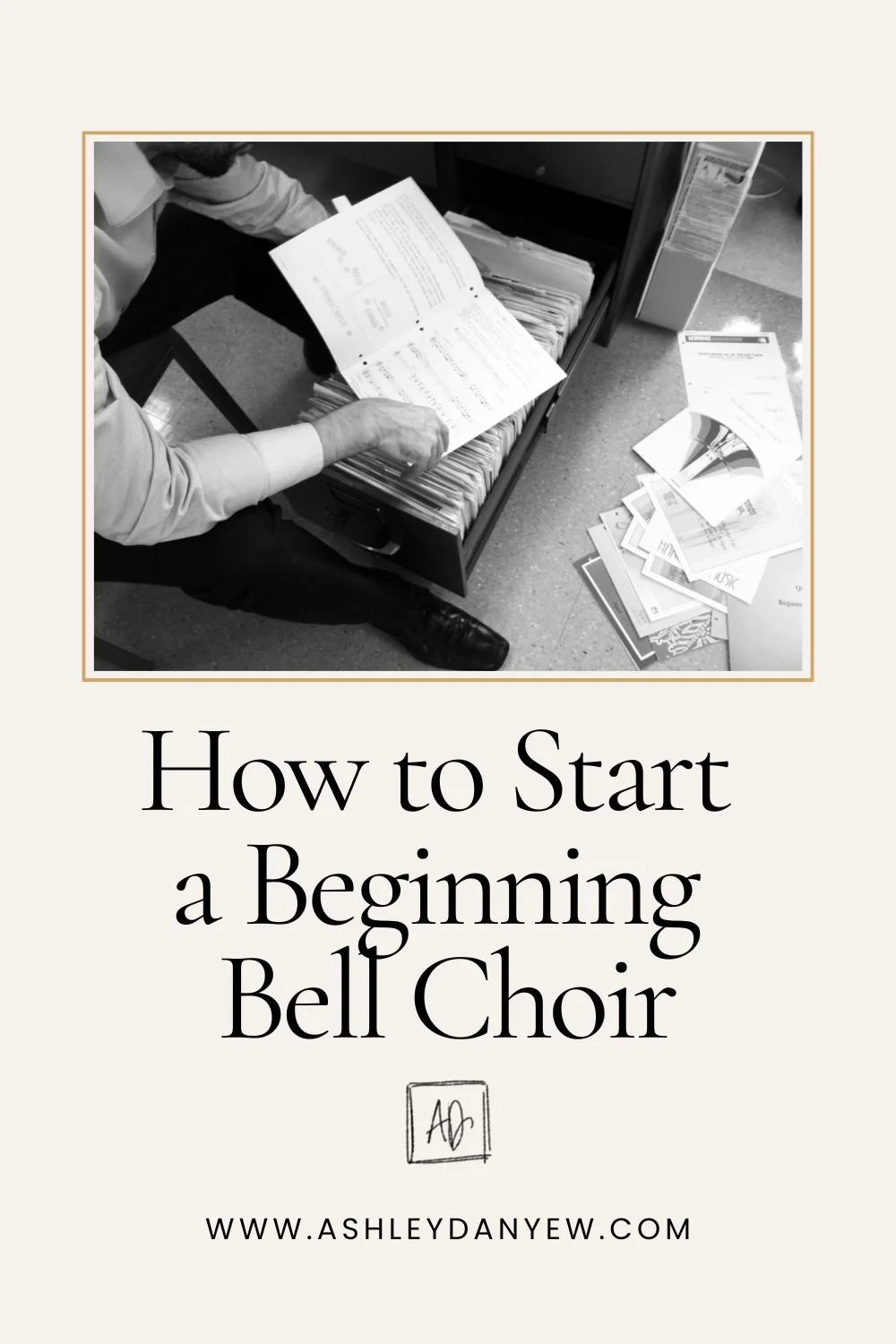Sometimes, it can be hard to find the right piece of music.
You know, the one that fits with the lectionary, has the right number of bells for your group, and provides the right balance of accessibility and challenge.
It can feel like trying to find a needle in a haystack.
A solution? Writing your own music. Have you ever considered it?
Maybe you’ve never considered yourself a composer, but with a few simple part-writing rules and a few repeatable patterns, you can create a piece of music that is unique to your specific ensemble and your players’ individual abilities.
In this post, I’ll walk you through the process, step by step. Let's start with something small—a simple handbell processional.
What is a Handbell Processional?
A handbell processional is a short piece often used as an introit, fanfare, or acclamation.
Processionals are often based on repeated patterns (1-2 measures in length), which makes them easy to learn and play from memory. They are particularly effective when played from the balcony, narthex, or while walking in and/or out of the sanctuary.
Processional Examples
Here are a few audio/video examples of handbell processionals, to give you an idea of what they’re like:
There are a few collections out there, though most call for a minimum of 14 bells and include dotted rhythms and rest patterns that may be challenging for a beginning group:
Processionals for the Time of Lent (Barbara Semmann) - 5 octaves
Processionals for the Time of Easter (Barbara Semmann) - 5 octaves
Processionals for the Day of Pentecost (Barbara Semmann) - 5 octaves
Four Easy Handbell Processionals (arr. Michael Burkhardt) - 3 octaves
Processionals for Handbells (John Behnke) - 3-5 octaves
Hymn Processionals for Handbells (arr. Hefner) - 3 octaves
Three Processionals for Handbells and Chimes (Downey) - 3-5 octaves
Well-Tempered Handbell Processionals (arr. Charles E. Peery) - 2-3 octaves or 4-5 octaves
Six Processionals (Sandra Eithun) - 3-5 octaves
A Step-by-Step Guide to Writing Your Own Handbell Piece
Okay. Ready to step outside the box, be creative, and channel your inner composer? Let's get started:
Step 1: Determine the number of bells
Think about the number of people in your group and how many bells they can play without putting any down.
For example, if you have four ringers that can play two bells, one that can play three, and one that is doing well to keep up with one, write your acclamation for 12 bells. Also, keep in mind that low bells (e.g. C3) will require two hands to ring.
Step 2: Choose a key and meter
Think about the tone of the service and whether you want the acclamation to be in a major or minor key (or maybe pentatonic!). Choose the meter. (Pro tip: duple or quadruple meter—2/4 or 4/4—will work best for processing.)
Step 3: Decide on style and range + assign bells
Think about the level of your group and what they'll be able to play well. Keep in mind that more experienced ringers will be able to play more independently and could do some melodic playing. If this is the case in your group, you might write a short repeated melody in the higher bells with a more chordal accompaniment in the lower bells.
Less experienced ringers will do better playing more often (it’s easier to keep track of where you are and not get lost!), so you might consider a more chordal-style piece. Think about simple chord changes (I and V7, and maybe IV) and give everyone at least one bell that fits into every chord.
A general rule of thumb is to think about how to move smoothly between chords with bells that are right next to each other.
For instance, in the key of C major, C fits in the I chord and the IV chord, and B (right next door!) fits in the V or V7 chord. Similarly, E fits in the I chord, while F (right next door!) fits in the IV and V7 chords. G fits in the I and V7 chords and A fits in the IV chord.
If that sounds like an overwhelming amount of music theory, here’s an iconic depiction of how these parts move and how to assign them to four ringers:
Once you've determined the style and range for your piece, write out a list of bells you will use and assign ringers.
Step 4: Outline the form and structure of the piece
The biggest question you'll need to ask yourself here is: Will everyone come in together and play the whole time, or will one person start and others join in? This might depend on if you plan to stand and play in place or process and play.
One idea is to have everyone begin together, process in any order, and end with a tonic chord (usually, whatever people have on the first beat of their pattern).
Alternatively, you might have the low bells begin, with others joining as they enter the sanctuary (this is also effective when standing in place). Depending on the tone of the service, it can also be effective to end the piece this way, with players gradually dropping out until just one part remains (this is particularly effective during Lent, as you can hear in Lenten Processional).
Step 5: Create a few rhythm patterns
Based on the meter you chose, choose a few rhythm patterns (one measure in length) that would work well as an ostinato, or repeated pattern. For instance, in quadruple meter, you might have:
Free Resource
Simply download, print, cut, and play.
This free printable card set features 16 rhythm patterns cards in 4/4 time. Use them for call-and-response, a composition-based gathering activity, teaching a new song or anthem, or developing musical awareness and listening skills. Looking for more ideas? See this post.
Step 6: Pair notes and rhythms + add melodic material
Go back to your list of bells from Step 3.
Assign slower, steadier rhythms to lower bells and more active rhythms to higher bells. If you’re incorporating a melodic line, set those bells aside and assign rhythm patterns to the remaining bells. Then, write a simple 2-measure melody using mostly stepwise motion.
Step 7: Give your piece a title
You can't go wrong with "Handbell Processional in ___ (key)," but if the title will be printed in the bulletin, you might consider something a little more programmatic that ties into the service: "Lenten Reflection" (Lent), "Procession to Jerusalem" (Palm Sunday), or "Joyous Morning" (Easter).
Step 8: Introduce the piece to your group
It's probably easiest to teach the piece by rote, but depending on how many ringers you have and how many different parts you need to teach, it might be helpful to write out a small index card for each player with their bell assignment and rhythmic notation (here’s a secret shortcut: use a set of rhythm pattern cards and notate the bell assignments on the back).
For music-readers, print the pattern they play using standard music notation. For non-readers, notate the rhythm and write the letter names underneath.
Closing
And there you have it! Your very own handbell processional (hopefully, the first of many!).
I hope these steps are helpful to you. Let me know how it turns out!
P.S. Need a little inspiration?
Download “Glorioso”—a short, festive acclamation or introit for 16 bells. Perfect for your beginning bell choir (the piece is built on simple, repeated rhythmic patterns—no music required!). Works well as a processional (if your group can ring and walk at the same time!).
A few favorite handbell posts + resources:
5 Creative Ways to Use Handbells in Worship
Free Music for Handbell Choirs
Printable Rhythm Pattern Card Set (192 cards)
Adventures in Bell Ringing: Improvisation Activities
50 Pieces for the Small Handbell Choir
























![Handbell Notation Guide [Infographic]](https://images.squarespace-cdn.com/content/v1/585c710603596e2c47dad93e/1491403915874-P2UH6FM8J1W1HM4UWP17/Handbell+Notation+Guide-02.png)


![The Joy of Children's Handbell Choirs [Video]](https://images.squarespace-cdn.com/content/v1/585c710603596e2c47dad93e/1482458472572-UQOTZ604Q6UKSIBZVYEZ/image-asset.png)










